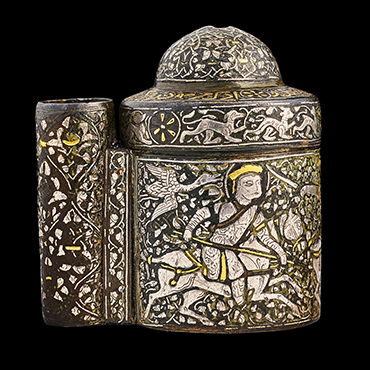Exquisite penmanship
Inscribed:
If you open the pen case of glory and divine favors,
Then make your ink from liberality and generosity.
The inscription on this inkwell clearly encourages its owner to be generous. Recognized as the finest and best-preserved of all later medieval Islamic inkwells, it has been referred to as a court inkwell and is closely linked to a similarly decorated travelling pen case and inkwell set with an inscription that explicitly refers to government (al-dawlah).[1] The rich decoration of these two pieces demonstrates the importance of literacy and the power of the pen in the medieval Islamic world. This pen case shares so many details with an inlaid brass wallet depicting the Mongol court, that there is no doubt that it came from a Mongol court workshop in the early 8th century AH/14th century CE. A recent study firmly places the workshop that produced it in the city of Mosul, well known for its metalworking ateliers.[2]
The depiction of the figures conveys outstanding vitality and movement, unusual in a medium that requires painstaking attention to detail and labor-intensive skill. One particularly striking figure is shown pulling the head of his horse to face the rider who is gaining on them. The way this figure is presented exemplifies the elegant fusion of artistic influences found at the Ilkhanid Mongol court during this period. In the Great Mongol Shahnama (Book of Kings) the hero Iskandar is shown as a crowned figure whose horse has a similarly turned head, as he fights a mythical beast.[3] While the style of the painting displays strong Chinese elements, it is suggested that the portrayal of the horse was inspired by European imagery of the time.
The inkwell is the earliest example of a shape that became popular in later centuries in Iran. Smaller and lighter than its predecessors, it is as suitable for carrying as for being placed on a work surface—very appropriate for the highly mobile court of the Mongol Ilkhans.
Exquisite penmanship
Royal Inkwell and cover
Mosul, Iraq, AH 700–30/1300–30 CE
Brass sheet, silver, gold and black composition inlaid, engraved, h. 5.6 × w. 5.5 cm, base: diam. 3.8 cm
Furusiyya Art Foundation, R-2032

